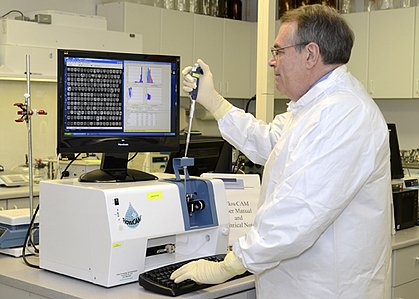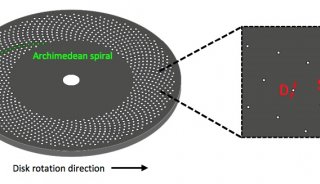检测机构使用流动成像显微镜来表征蛋白质聚集体(一)
Contract Lab Using Flow Imaging Microscopy to Characterize Protein Aggregates
检测机构使用流动成像显微镜来表征蛋白质聚集体 Posted by Joyce Brown
Posted by Joyce Brown
Joyce Brown发表
Dan Berdovich knew there were protein aggregates in his customer’s
parenteral sample but despite an assortment of high-tech instrumentation
at his disposal, he couldn’t be completely confident he was seeing them
all or getting a precise count.
Dan Berdovich了解他客户的肠外样品中有蛋白质聚集体,但尽管有各种各样的高科技仪器可供他使用,但他仍然无法完全确信他能看到它们或获得精确计数。
For an authority on particle analysis who’d earned an award for a
peer-reviewed paper on visual inspection standards of injectable drug
products, it was disconcerting. Using imaging particle analysis,
however, a technology available to industrial markets for less than a
decade, Berdovich’s efforts to solve his customers’ problems led to his
own business success.
对于颗粒分析的权威机构,他们获得了关于注射药物产品目视检查标准的同行评审论文奖,这令人不安。 然而,使用颗粒成像分析,虽然在工业市场的技术应用不到十年,但是Berdovich努力解决客户的问题以至他自己的业务获得成功。
His company, Wheeling, Ill.-based contract laboratory Micro Measurement Laboratories, Inc.,
does particulate matter testing, particle identification, method
validation and visual inspection standards development for
pharmaceutical and biotechnology companies world wide, among other
services.
他的公司位于伊利诺伊州惠灵的实验室Micro Measurement Laboratories,Inc。为世界各地的制药和生物技术公司以及其他公司进行颗粒物测试,颗粒识别,方法验证和视觉检测标准开发。
The company offers particular expertise in standards and recommendations
set by the U.S. Pharmacopeial Convention (USP), including USP
<787>, which covers the testing of sub-visible particulate matter
in therapeutic protein injections; USP <788>, which covers testing
for and reporting of sub-visible particulate matter in injections and
parenteral infusions; and the forthcoming USP <790>, which covers
the inspection of visible particulates in injectable drug products;
along with the revisions USP <1787>, <1788> and
<1790>.
该公司在美国药典委员会(USP)制定的标准和建议方面提供了特殊的专业知识,包括USP
<787>,其中包括治疗性蛋白质注射中亚可见颗粒物的测试; USP
<788>,其中包括注射和肠胃外输注中亚可见颗粒物的测试和报告; 以及即将出版的USP
<790>,其中包括检查注射药品中的可见微粒; 以及USP
<1787>,<1788>和<1790>的修订版。
“I was getting very frustrated that when it came to sub-visible or
semi-transparent particles like proteins, we were essentially in the
dark,” says Berdovich, “and USP <788> is our bread and butter.”
“我非常沮丧的是,当遇到像蛋白质这样的亚可见或半透明颗粒时,我们基本上处于黑暗中,”Berdovich说,“USP <788>是我们的面包和黄油。”
Why it hurt
为什么会沮丧
Berdovich’s team used light obscuration instruments to detecting protein
aggregates and other particles, as prescribed in USP <788>. The
problem, he realized, was that light typically travels through the
particles without being scattered. Proteins and protein aggregates,
along with other translucent and transparent particles, often defy
detection by even the finest light obscuration devices, especially when
in the sub-visible range of less than 20 um. Additionally, much larger
particles are often severely undersized when measured, if detected at
all.
Berdovich的团队使用光阻法仪检测蛋白质聚集体和其他颗粒,如USP <788>所述。
他意识到,问题在于光线通常穿过颗粒而不会散射。
蛋白质和蛋白质聚集体以及其他半透明和透明的颗粒,即使是最好的光阻法装置也经常无法检测,特别是在小于20微米的亚可见光范围内。
另外,如果检测到的话,更大的颗粒通常在测量时测量尺寸会小于实际尺寸。
Characterizing protein aggregates is even more challenging using manual
visual inspection-looking at individual vials under controlled lighting
conditions and determining whether visible particles are present using
the naked eye. This method has limitations similar to those using light
obscuration, and because it is inherently subjective, it can yield
unreliable results, especially in some biologics and lyophilized drugs.
使用手动目视检查表征蛋白质聚集体更具挑战性 - 在受控光照条件下观察单个样品瓶,并使用肉眼确定是否存在可见颗粒。 该方法具有类似于使用光阻法的局限性,并且因为其本质上是主观的,它可以产生不可靠的结果,尤其是在一些生物制剂和冻干药物中。
At present, 100% visual inspection is required for visible particulates
and two methods, light obscuration and membrane microscopy, are accepted
by USP to test for the presence of sub-visible particles in parenteral
formulations.
目前,可见颗粒需要100%目视检查,USP接受两种方法,即光阻法和膜显微镜法来测试肠胃外制剂中亚可见颗粒的存在。











